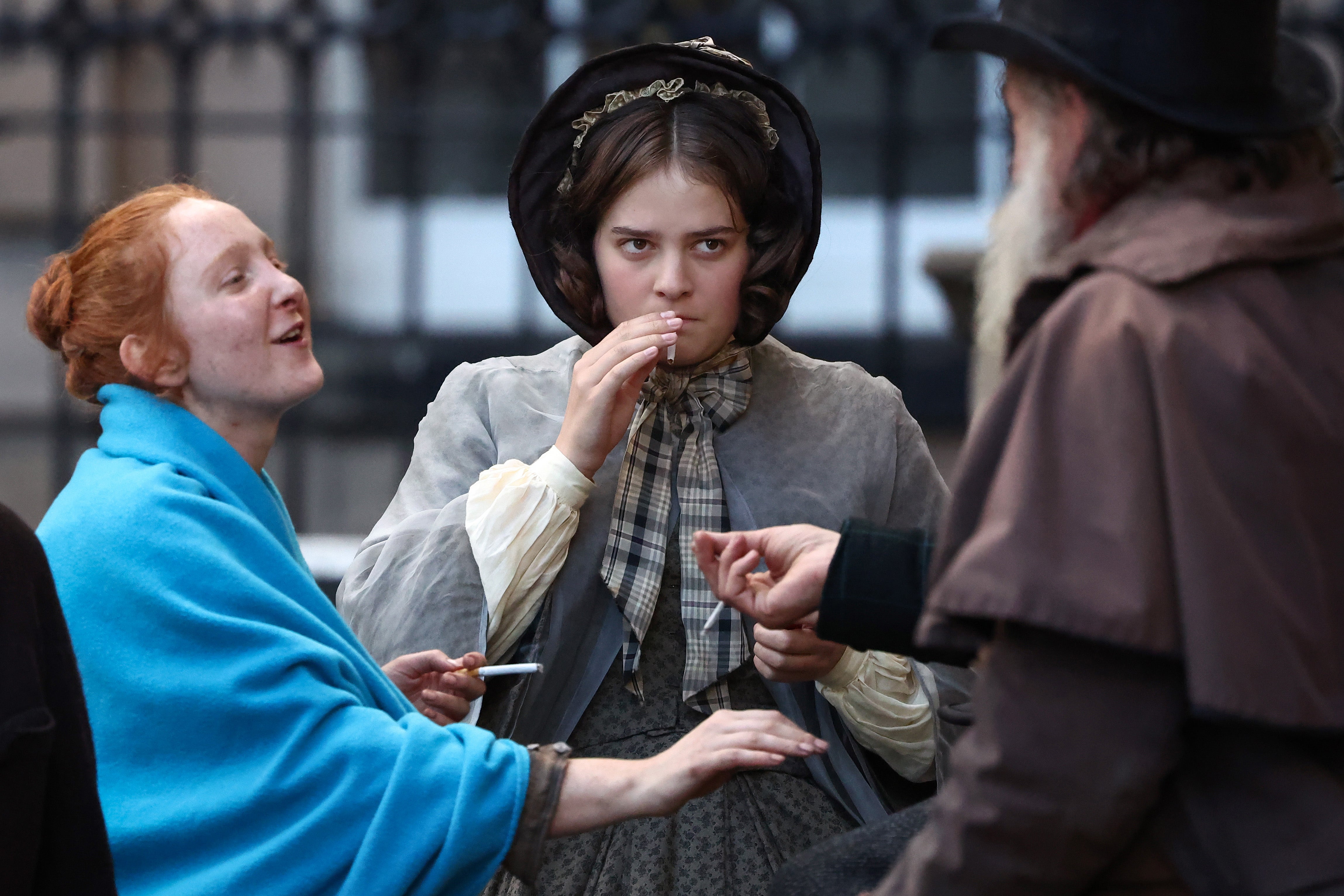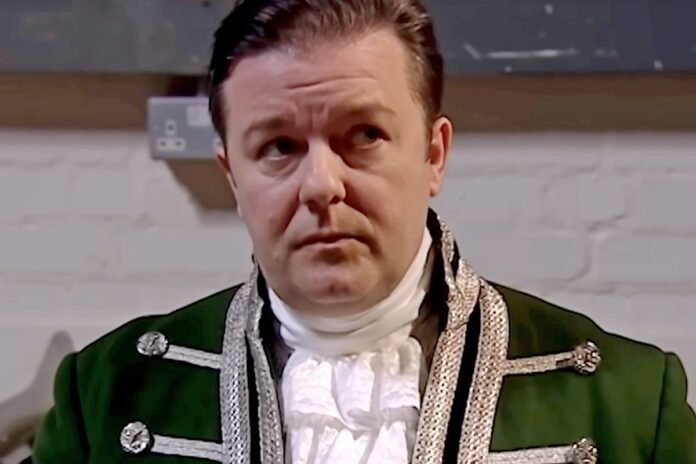Supporting artists. Background performers. Walk-ons. Extras. There are many terms to describe the men and women who populate the world of film and TV. It is a strange life, integral to the production yet performed by a motley crew of students, retirees and semi-professional thesps. Halfway between actors and scenery, this unromantic role has been jeopardised by the rise and rise of AI-generated imagery. It’s a turn of events few would have seen coming back in July 2005, when their industry was immortalised in one of the BBC’s most popular ever comedy series.
How do you follow the most acclaimed British sitcom since Fawlty Towers? That was the challenge for Ricky Gervais and Stephen Merchant after The Office concluded in 2003. The answer was Extras, which premiered on BBC One 20 years ago this week. It centres on the travails of Andy Millman – played by Gervais – a serial “extra”, who spends his days on set chatting inanely with his best friend Maggie (Ashley Jensen), dreaming of getting his break, and badgering the show’s celebrity guests. The first series featured Hollywood superstars like Ben Stiller, Kate Winslet and Samuel L Jackson, highlighting the huge disparity between the A-listers and Andy’s cohort, who are treated largely as disposable, fleshy props.
“I think there was just a huge expectation that it was going to be as good as The Office,” says Shaun Pye, a comedy writer and actor who played Andy’s nemesis, Greg, in Extras. “Which put a bit of pressure on it!” With Extras, Gervais and Merchant were once again picking at a scab on the human condition: the desire to better your station. They depicted Andy held at arm’s length from happiness by his own ambition, and Maggie in a mirror crisis of her own romantic aspirations. Two decades later, it doesn’t have the same cult reputation as The Office, nor has it spun off infinite foreign adaptations (Amazon Prime Video has recently announced a Mexican version, La Oficina). Yet the show is still cringe-inducingly funny and an oddly poignant portrait of the suffering that people endure for art.
“This isn’t acting,” Andy laments, “getting the back of your head or your arm in a shot.” And yet, for all that the job thwarts Andy’s creativity, for many of the real-life extras I speak to, the role is more nuanced. Alex, from Edinburgh, started his career in animation before deciding to turn his hand to acting. While studying at Dundee & Angus College, he signed up for supporting artist work to get some on-set experience. “I can wait the whole day – 10 hours – and then, if I’m performing for those last 30 minutes, it’s worth it,” he tells me. “It just comes down to the individual, I think.”
“It must suit some people’s temperaments,” concurs Pye. “It’s enormously long hours, you don’t get treated well generally – maybe there’s something exciting about being on telly.” Some are brilliantly professional, others less so. On The Increasingly Poor Decisions of Todd Margaret, which Pye co-wrote with comedian David Cross, there was one extra who stood out. “She just kept laughing,” he recounts. “She was watching it like she was a member of the audience. She was quite adorable really; I just wonder what her psychology was.” In her defence, extras are sometimes abandoned to their task by preoccupied directors: a recent viral moment from Doctor Strange in the Multiverse of Madness showcased a hapless background actor trying to look natural while Benedict Cumberbatch, in the foreground, mumbled away about how he was “distracted being dust for five years”. The clip prompted more affection than abuse, and, frankly, she steals the scene.
But these moments are all too rare, because not every extra is a frustrated headliner trying to inch their way into shot. Wayne Berko – the CEO of Uni-versal Extras, one of the UK’s largest casting agencies for supporting artists – has a roster that spans the full range of people. “Our background actors come from all walks of life,” he says. “Teachers, dancers, students, police, musicians, fitness instructors, nurses. We’ve got retirees, people in their eighties. That’s the beautiful thing about what we do.” The richness of this tapestry is a downstream impact of the fact that supporting actors are one of the last remaining roles on major sets that are not fully professionalised (“You can’t really make a living from being an extra,” a bonneted woman on the set of a period drama sneeringly informs Andy). And so, anyone can pick up a shift here and there, like being a seasonal worker in a department store, applying the elf ears every December.
There are thousands of people who have appeared, smudge-like, in the background of film and TV, but only a lucky few have managed to snag a line of dialogue and earn the role of a “featured extra”. I speak to one of them, Zoe, who got a small speaking part in Michael Winterbottom’s The Look of Love. At the time, Zoe was the managing director of a major London-based software company, who had stumbled onto the set at the suggestion of a friend. “Winterbottom likes to cast the extras as people who do the real jobs,” she recounts, having been asked to join a media scrum thanks to some (quite tangential) historic journalism work. “It was the first time I’d ever been on a film set, learning how everything worked, how all the fancy actors had their own dressing room and I was in the extras dressing room.” In exchange for £100 (a £20 bump on the film’s standard day rate for an extra), Zoe shared a scene with Steve Coogan. She confesses that she, like many aspiring actors, would have paid good money for that experience.
Still, the profession (OK, the semi-profession) is imperilled. In 2023, the US film and television industry was rocked by a series of strikes led by the actors’ union over concerns about the ability to train AI to replicate a performer’s likeness. The backlash shut down productions and demonstrated the continued bargaining power of performers. But do extras have as many chips? Berko is equivocal on whether his agency would work with a company developing AI-generated supporting artists. “If it’s something that would take jobs away from our people, then the answer would probably be no,” he considers. “But if it’s something that is a benefit for our people and society, and the guys that take part are fairly compensated for it, then it’s definitely something we would think about.”
With AI generating more scary headlines than a Westminster party, it can be easy to assume that these tools are, to quote a former prime minister, oven-ready. That might not be the case. Ben Kent, director of research at Foundry, a major developer of visual effects software, has been working on new AI tools that have been used on films such as Dune: Part Two. “Video generation is really good if you just want to create an entirely new shot and don’t care too much about exactly what’s in it,” he demurs. “But if you’re particular about the action and the camera, or you want to composite it with other stuff? It’s kind of hard.” He thinks, however, that these issues will be solved “within five years”.

We are living through a period of great change for the entire industry. But as Kent points out, “throughout film history, crowd scenes haven’t necessarily used real actors anyway”. Star Wars, for example, used matchsticks to stand in for the crowds at Tatooine’s pod races. This fudge has been a long time in the making: Peter Jackson deployed over 20,000 extras on his Lord of the Rings trilogy (it is said that 1 in every 160 New Zealanders was part of the production), yet many of the bigger crowd scenes involve a complex combination of costumed actors and CGI models.
The question, for the past couple of decades, has been why anyone would privilege expensive, unconvincing CGI renders over the economical horde of supporting actors. According to Berko, Uni-versal Extras’ rate card has a base rate of £134.85 in central London for an eight-hour day (the rate falls to £123.15 for a nine-hour day outside London, due to those extras being governed by a different union). In the mega-budget world of Hollywood film and TV, that isn’t a lot of money (Alex recalls extras being served a three-course meal on the set of spooky thriller The Rig – “that’s what Amazon money gets you”). But AI is changing that equation, making digitally generated “matte painting” – the creation of backdrops and landscapes against which to set the action – more cost-effective than ever.
“It just becomes a question of how good it is and how much it costs,” says Zoe, who continues to juggle a career as a tech executive with acting roles. “On the lower budget end, people will use AI-generated crowds all the time; the pinnacle of craft will still be to use real people.” Pye, who has only acted a handful of times since his breakout role, agrees. “I would feel a bit cheated,” he says, “if I was watching something and thought that the people reacting in the background were doing it because of an algorithm.”
For all that there is romance to this last bastion of Hollywood amateurism, it is unclear how much audiences would really notice their extinction. After all, even Extras – an ode to the unsung – was marketed, primarily, through its celebrity cameos. Gervais may have been squeezed into an unassuming windbreaker, but at the same time he was courting Hollywood. A couple of years after Extras aired, he would be hosting the Golden Globes. Extras was never really about the extras.
“Humans and tech working together and harnessing AI for good,” muses Berko. “It can be done, and it should be done.” Superficially, AI might offer an existential threat to agencies like his, but there are opportunities here, too. Some productions will use supporting artists as a hedge bet against AI slop, while other companies will require armies of faces for data collection. It might not have the same allure as rubbing shoulders with Oscar winners or appearing in a drone shot behind James Bond, but it’s still a small part to play in the business.
Because 20 years after Extras, the truth that Gervais and Merchant hit upon is still resonant. Film and television are the sum total of their constituent parts. Some of those pieces – the auteur director or the hunky leading man – are big, while others are small. But all conspire towards a dream of art. As the great philosopher of performing, Konstantin Stanislavski, famously said, “There are no small parts, only small actors.” The same, it seems, is true of the great and complicated machine that keeps making our films and television shows.






